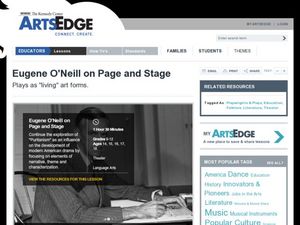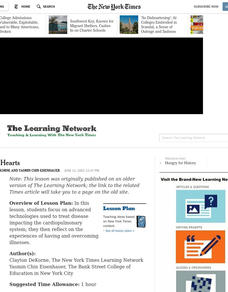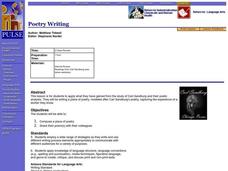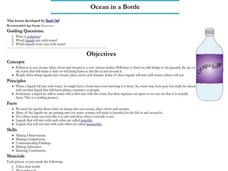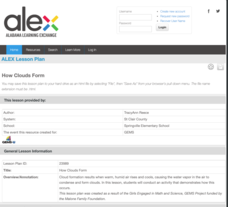Curated OER
How Does Your Garden Grow?
Learners read The Garden by Arnold Lobel, plant seeds to discover what makes them grow, and record their observations in their journals.
Curated OER
Polar Express Lesson Plan
Students develop a podcast as they retell the story of The Polar Express. In this early childhood lesson plan, students experience technology by creating a podcast. Students also create illustrations to be scanned for the podcast.
Curated OER
Eugene O'Neill on Page and Stage
Learners investigate the life and works of Eugene O'Neill. In this American theater lesson, students read biographical information about O'Neill and review Long Day's Journey into Night. Learners then analyze the play in order to deliver...
Curated OER
No Regrets: a Poetry Analysis
Students read a poem and use the TPCASTT strategy for analysis. In this poetry analysis lesson, students journal about their future goals and read John Updike's "Ex-Basketball Player." Students discuss the purpose of the poem and...
Curated OER
Variable Skies
Young scholars examine factors which affect a vortex and create model tornadoes. They identify variables, pose a testable question, and perform an experiment using the scientific method. After they collect their data, students write a...
Curated OER
Healthy Hearts
Young scholars focus on advanced technologies used to treat disease impacting the cardiopulmonary system; they then reflect on the experiences of having and overcoming illnesses.
Curated OER
Talking Trash - Online Message Boards
Students consider their own experiences with online message boards and chat rooms, discover how teens are using the Web to talk about people in their lives, discuss the issues surrounding online conversations.
Curated OER
Musical Imagery
Young scholars experience musical imagery. They link this musical concept to literary imagery to gain an understanding of the use of imagery in both genres. After listening to a varriety of sounds, students will compose and perform a...
Curated OER
A Valid Conclusion? Testing and Reporting on Hypotheses Using the Scientific Method
Students explore importance of accuracy in reporting, focusing particularly on articles documenting scientific discoveries, and practice scientific method by conducting experiments to test and report on scientific hypotheses.
Curated OER
Would You Believe Your Eyes?
Students study the parts and functions of the human eye. They create dodecagons which are twelve-sided figures with twelve equal angles and share these with the class so that each student can begin to see how many different illusions can...
Curated OER
From America, With Love
Students research the experiences of specific immigrant groups in the United States. Letters are written from imaginary immigrants to relatives in their countries of origin, including historically accurate details.
Curated OER
Reluctant Immigrants
Students examine the reasons why people from Nigeria have immigrated to the United States. They read and describe a refugee's experience leaving her home country. They view a video clip as well.
Curated OER
Baseball Memories
Students act as historians by, first, reading and analyzing oral histories of professional baseball players to become familiar with baseball figures. Then, they proceed to interview family members, relatives, or neighbors who have...
Curated OER
Immigration and Photography: The Case of Lewis Hine
Students are introduced to the characteristics of documentary photography. Individually, they cut out a paper frame and view their classroom through the "lens" and at different angles. After veiwing photographs, they practice...
Curated OER
Postcards From Mars
Fifth graders research and explore what life would be like for human colonists on Mars. They explore various websites, read and discuss newspaper articles, develop a chart of the hardships and conditions that would be faced by colonists...
Curated OER
Poetry Writing
Students compose a piece of poetry modeled after the poetry of Carl Sandburg and share their poem(s) with their colleagues. They use a cluster diagram to organize their thoughts and brainstorm their ideas.
Curated OER
Solids, Liquids and Gases
Students are introduced to the various states of matter. After watching a video, they discover how to compare the three states using its shape and volume. In groups, they participate in an experiment with solids, liquids and gases and...
Curated OER
Good News/Bad News/Who Cares?
Students practice evaluating facts, bringing to bear their own experience, preferences, and international contexts. They recognize that there are many ways of interpreting a single piece of information and form the habit of reflecting...
Curated OER
NUMB3RS Activity: Riding the Waves
High schoolers use the TI-Navigator system to explore vector fields and make predictions. They also identify what a vector field is and that it represents the movement of water. Pupils try to determine where a bottle floating might have...
Curated OER
Corn Cob Painting
Students explore creativity and imagination. In this activity about art, students experiment with different tools used for creating prints. Students use ears of corn with kernels and without kernels, tempera paint, paper plates for the...
Curated OER
Reporting Live from the 20th Century!
Students read and write newspaper articles. In this newspaper article writing activity, students collect and share current news articles, examine how they are written, then choose an event from the 20th century and write their own news...
Curated OER
Ocean in a Bottle
Students investigate pollution in water. In this pollution lesson, students participate in an experiment to simulate water pollution. Students observe how the water reacts to the "pollution."
Alabama Learning Exchange
How Clouds Form
Young scholars analyze how clouds form. In this cloud formation lesson, students brainstorm types of clouds and what they think they're made of. Young scholars conduct an experiment to see how clouds form and discuss their observations....
Curated OER
December Celebrations
Students study customs of various winter holidays. In this holiday lesson, students read the book The Reasons for the Seasons and complete a winter glyph. Students use graphing software to create a chart of the holidays that are celebrated.


